Prediction of Axial Capacity of Concrete Filled Steel Tubes Using Gene Expression Programming
Abstract
1. Introduction
2. Methodology
2.1. Database Compilation
2.2. GEP Modelling
3. Results & Discussion
3.1. Variation of Genetic Parameters
3.2. Models’ Performance
3.2.1. Statistical Evaluation
3.2.2. Comparison of Regression Slopes
3.2.3. Model Predicted to Experimental Ratio (P/E)
3.3. GEP Formulations
3.4. Parametric and Sensitivity Analysis
4. Conclusions
- The performance of the developed models was assessed using variety of performance indices, i.e., R2, RMSE, MAE and comparison of regression slopes. It was found that Model T3 having Nc = 100, Hs = 8 and Ng = 3 was the optimally performing model among all others. The model exhibits the highest R2 value of 0.99, and the lowest RMSE = 133.4 and 162.2 and MAE = 92.4 and 108.7, in the training and testing phases, respectively.
- Similarly, the comparison of regression slopes analysis reveals that the Model T3 possess the highest value of R2 equaling 0.99 and m = 1, which represents its high performance and robustness.
- Finally, the parametric analysis depicts that the Pu of CFSS columns increases linearly with the value of D, t and fy while, Ec, Es and the ratio of D/t had the least influence on the output parameter. The sensitivity analysis of input variables reveals that the ζ is recorded to have the highest value of sensitivity (59%) whereas L/D has the least effect (i.e., 0.2%) in governing the Pu of the CFSS.
- It is highly recommended to use the prediction equation (Equation (4)) for input variables whose range and other details are considered in the descriptive statistics of the current study. The following simple-to-use mathematical expression can be used to predict the Pu of the CFSS with higher accuracy.
Author Contributions
Funding
Institutional Review Board Statement
Informed Consent Statement
Data Availability Statement
Acknowledgments
Conflicts of Interest
References
- Sun, Z.; Chen, Y.; Xu, S.Y.; Sun, Y.; Wu, G. Shaking table test of concrete columns hybrid reinforced by steel/FRP bars. J. Build. Eng. 2022, 48, 103938. [Google Scholar] [CrossRef]
- Melo, J.; Afshan, S.; Rossetto, T.; Varum, H.; Arêde, A. Experimental and numerical investigation of the cyclic response of stainless steel reinforced concrete columns. Eng. Struct. 2022, 252, 113607. [Google Scholar] [CrossRef]
- Zhao, X.; Wen, F.; Yan, S. Behavior of multi-steel reinforced concrete columns with encased steel H-sections. Eng. Struct. 2022, 264, 114463. [Google Scholar] [CrossRef]
- Zhuang, M.-L.; Sun, C.; Dong, B. Experimental and numerical investigations on seismic performance of HTRB630 high-strength steel bars reinforced concrete columns. Case Stud. Constr. Mater. 2022, 17, e01185. [Google Scholar] [CrossRef]
- Golewski, G.L. A novel specific requirements for materials used in reinforced concrete composites subjected to dynamic loads. Compos. Struct. 2019, 223, 110939. [Google Scholar] [CrossRef]
- ACI 318-14; ACI Committee 318, Building Code Requirements for Structural Concrete (ACI 318-14): Commentary on Building Code Requirements for Structural Concrete (ACI 318R-14)—An ACI Standard and Report. American Concrete Institute: Farmington Hills, MI, USA, 2014.
- EN1994-1; Design of Composite Steel and Concrete Structures—Part 1-1: General Rules and Rules for Buildings. European Committee for Standardization: Brussels, Belgium, 1994.
- Radovanovic, M.M.L.; Nikolic, J.Z.; Radovanovic, J.R.; Kostic, S.M. Structural Behaviour of Axially Loaded Concrete-Filled Steel Tube Columns during the Top-Down Construction Method. Appl. Sci. 2022, 12, 3771. [Google Scholar] [CrossRef]
- Zhang, J.; Liu, Y.; Chen, Z.; Cai, R.; Li, X. Seismic behavior of high-strength concrete-filled square steel tube columns reinforced with ultrahigh-strength reinforcing bars. Structures 2021, 34, 3125–3140. [Google Scholar] [CrossRef]
- Shao, Z.; Zha, X.; Wan, C. Design method of fire-resistance capacity of reinforced-concrete-filled steel tube column under axial compression. Fire Saf. J. 2022, 129, 103572. [Google Scholar] [CrossRef]
- Zhang, T.; Ding, F.X.; Liu, X.M.; Yu, Z.W. Seismic behavior of terminal stirrup-confined concrete-filled elliptical steel tube columns: Experimental investigation. Thin-Walled Struct. 2021, 167, 108251. [Google Scholar] [CrossRef]
- Huang, Y.; Zhao, P.; Lu, Y.; Zhang, H. Push-out tests of CFST columns strengthened with self-compacting and self-stressing concrete filled square steel tube. J. Constr. Steel Res. 2022, 193, 107263. [Google Scholar] [CrossRef]
- Feng, W.; Wang, Y.; Sun, J.; Tang, Y.; Wu, D.; Jiang, Z.; Wang, J.; Wang, X. Prediction of thermo-mechanical properties of rubber-modified recycled aggregate concrete. Constr. Build. Mater. 2022, 318, 125970. [Google Scholar] [CrossRef]
- Zhao, P.; Huang, Y.; Liu, Z.; Wang, H.; Lu, Y. Experimental research on seismic performance of steel fiber-reinforced recycled concrete-filled circular steel tube columns. J. Build. Eng. 2022, 54, 104683. [Google Scholar] [CrossRef]
- Wang, X.; Fan, F.; Lai, J. Strength behavior of circular concrete-filled steel tube stub columns under axial compression: A review. Constr. Build. Mater. 2022, 322, 126144. [Google Scholar] [CrossRef]
- Jahangir, H.; Soleymani, A.; Esfahani, M.R. Investigating the Confining Effect of Steel Reinforced Polymer and Grout Composites on Compressive Behavior of Square Concrete Columns. Iran. J. Sci. Technol. Trans. Civ. Eng. 2022, 1–17. [Google Scholar] [CrossRef]
- Tang, Y.; Zhu, M.; Chen, Z.; Wu, C.; Chen, B.; Li, C.; Li, L. Seismic performance evaluation of recycled aggregate concrete-filled steel tubular columns with field strain detected via a novel mark-free vision method. Structures 2022, 37, 426–441. [Google Scholar] [CrossRef]
- ANSI/AISC 360-16; Specification for Structural Steel Buildings. American Institute of Steel Construction (AISC): Chicago, IL, USA, 2016.
- Won, D.; Kim, S.; Seo, J.; Kang, Y.-J. Experimental Study of Composite Hollow RC Column under Uniaxial Compressive Load. Appl. Sci. 2019, 9, 373. [Google Scholar] [CrossRef]
- Lin, S.; Li, Z.; Lu, Z.-H.; Zhao, Y.-G. Experimental study on the behavior of circular ultra-high strength concrete-filled steel tube columns subjected to unequal end moments. Eng. Struct. 2022, 267, 114709. [Google Scholar] [CrossRef]
- Ci, J.; Ahmed, M.; Liang, Q.Q.; Chen, S.; Chen, W.; Sennah, K.; Hamoda, A. Experimental and numerical investigations into the behavior of circular concrete-filled double steel tubular slender columns. Eng. Struct. 2022, 267, 114644. [Google Scholar] [CrossRef]
- Mangalathu, S.; Jeon, J.S. Classification of failure mode and prediction of shear strength for reinforced concrete beam-column joints using machine learning techniques. Eng. Struct. 2018, 160, 85–94. [Google Scholar] [CrossRef]
- Munir, M.J.; Kazmi, S.M.S.; Wu, Y.F.; Lin, X.; Ahmad, M.R. Development of novel design strength model for sustainable concrete columns: A new machine learning-based approach. J. Clean. Prod. 2022, 357, 131988. [Google Scholar] [CrossRef]
- Santarsiero, G.; Mishra, M.; Singh, M.K.; Masi, A. Structural health monitoring of exterior beam–column subassemblies through detailed numerical modelling and using various machine learning techniques. Mach. Learn. Appl. 2021, 6, 100190. [Google Scholar] [CrossRef]
- Naderpour, H.; Mirrashid, M.; Parsa, P. Failure mode prediction of reinforced concrete columns using machine learning methods. Eng. Struct. 2021, 248, 113263. [Google Scholar] [CrossRef]
- Albero, V.; Ibañez, C.; Hernández-Figueirido, D.; Piquer, A. Experimental analysis on circular concrete-filled steel tubular beam-columns under unequal load eccentricities. Eng. Struct. 2022, 259, 114206. [Google Scholar] [CrossRef]
- Irandegani, M.A.; Zhang, D.; Shadabfar, M. Probabilistic assessment of axial load-carrying capacity of FRCM-strengthened concrete columns using artificial neural network and Monte Carlo simulation. Case Stud. Constr. Mater. 2022, 17, e01248. [Google Scholar] [CrossRef]
- Naderpour, H.; Nagai, K.; Fakharian, P.; Haji, M. Innovative models for prediction of compressive strength of FRP-confined circular reinforced concrete columns using soft computing methods. Compos. Struct. 2019, 215, 69–84. [Google Scholar] [CrossRef]
- Azim, I.; Yang, J.; Javed, M.F.; Iqbal, M.F.; Mahmood, Z.; Wang, F.; Liu, Q.-F. Prediction model for compressive arch action capacity of RC frame structures under column removal scenario using gene expression programming. Structures 2020, 25, 212–228. [Google Scholar] [CrossRef]
- Momeni, M.; Hadianfard, M.A.; Bedon, C.; Baghlani, A. Damage evaluation of H-section steel columns under impulsive blast loads via gene expression programming. Eng. Struct. 2020, 219, 110909. [Google Scholar] [CrossRef]
- Wang, H.; Wu, C.; Zhang, F.; Fang, Q.; Xiang, H.; Li, P.; Li, Z.; Zhou, Y.; Zhang, Y.; Li, J. Experimental study of large-sized concrete filled steel tube columns under blast load. Constr. Build. Mater. 2017, 134, 131–141. [Google Scholar] [CrossRef]
- Zhang, F.; Wu, C.; Wang, H.; Zhou, Y. Numerical simulation of concrete filled steel tube columns against BLAST loads. Thin-Walled Struct. 2015, 92, 82–92. [Google Scholar] [CrossRef]
- Koopialipoor, M.; Fallah, A.; Armaghani, D.J.; Azizi, A.; Mohamad, E.T. Three hybrid intelligent models in estimating flyrock distance resulting from blasting. Eng. Comput. 2019, 35, 243–256. [Google Scholar] [CrossRef]
- Iftikhar, B.; Alih, S.C.; Vafaei, M.; Elkotb, M.A.; Shutaywi, M.; Javed, M.F.; Deebani, W.; Khan, M.I.; Aslam, F. Predictive modeling of compressive strength of sustainable rice husk ash concrete: Ensemble learner optimization and comparison. J. Clean. Prod. 2022, 348, 131285. [Google Scholar] [CrossRef]
- Kaloop, M.R.; Bardhan, A.; Kardani, N.; Samui, P.; Hu, J.W.; Ramzy, A. Novel application of adaptive swarm intelligence techniques coupled with adaptive network-based fuzzy inference system in predicting photovoltaic power. Renew. Sustain. Energy Rev. 2021, 148, 111315. [Google Scholar] [CrossRef]
- Bui, D.T.; Nhu, V.H.; Hoang, N.D. Prediction of soil compression coefficient for urban housing project using novel integration machine learning approach of swarm intelligence and Multi-layer Perceptron Neural Network. Adv. Eng. Inform. 2018, 38, 593–604. [Google Scholar] [CrossRef]
- Abukhettala, M.; Fall, M. Geotechnical characterization of plastic waste materials in pavement subgrade applications. Transp. Geotech. 2021, 27, 100472. [Google Scholar] [CrossRef]
- Boğa, A.R.; Öztürk, M.; Topçu, I.B. Using ANN and ANFIS to predict the mechanical and chloride permeability properties of concrete containing GGBFS and CNI. Compos. Part B: Eng. 2013, 45, 688–696. [Google Scholar] [CrossRef]
- Lemonis, M.E.; Daramara, A.G.; Georgiadou, A.G.; Siorikis, V.G.; Tsavdaridis, K.D.; Asteris, P.G. Ultimate axial load of rectangular concrete-filled steel tubes using multiple ANN activation functions. Steel Compos. Struct. 2022, 42, 459. [Google Scholar] [CrossRef]
- Mjalli, F.S.; Al-Asheh, S.; Alfadala, H.E. Use of artificial neural network black-box modeling for the prediction of wastewater treatment plants performance. J. Environ. Manag. 2007, 83, 329–338. [Google Scholar] [CrossRef]
- Sarker, I.H. Deep Learning: A Comprehensive Overview on Techniques, Taxonomy, Applications and Research Directions. SN Comput. Sci. 2021, 2, 420. [Google Scholar] [CrossRef]
- Khan, M.A.; Aslam, F.; Javed, M.F.; Alabduljabbar, H.; Deifalla, A.F. New prediction models for the compressive strength and dry-thermal conductivity of bio-composites using novel machine learning algorithms. J. Clean. Prod. 2022, 350, 131364. [Google Scholar] [CrossRef]
- Amar, M.N.; Ghahfarokhi, A.J. Prediction of CO2 diffusivity in brine using white-box machine learning. J. Pet. Sci. Eng. 2020, 190, 107037. [Google Scholar] [CrossRef]
- Shahmansouri, A.A.; Akbarzadeh Bengar, H.; Ghanbari, S. Compressive strength prediction of eco-efficient GGBS-based geopolymer concrete using GEP method. J. Build. Eng. 2020, 31, 101326. [Google Scholar] [CrossRef]
- Naser, M.Z.; Thai, S.; Thai, H.T. Evaluating structural response of concrete-filled steel tubular columns through machine learning. J. Build. Eng. 2021, 34, 101888. [Google Scholar] [CrossRef]
- AS/NZS2327; Composite Steel-Concrete Construction for Buildings. Standards Austalia: Sydney, Australia; Standards New Zealand: Wellington, New Zealand, 2017.
- Sami Ullah, H.; Khushnood, R.A.; Ahmad, J.; Farooq, F. Predictive modelling of sustainable lightweight foamed concrete using machine learning novel approach. J. Build. Eng. 2022, 56, 104746. [Google Scholar] [CrossRef]
- Sarir, P.; Chen, J.; Asteris, P.G.; Armaghani, D.J.; Tahir, M.M. Developing GEP tree-based, neuro-swarm, and whale optimization models for evaluation of bearing capacity of concrete-filled steel tube columns. Eng. Comput. 2019, 37, 1–19. [Google Scholar] [CrossRef]
- Javed, M.F.; Farooq, F.; Memon, S.A.; Akbar, A.; Khan, M.A.; Aslam, F.; Alyousef, R.; Alabduljabbar, H.; Rehman, S.K.U.; Rehman, S.K.U.; et al. New Prediction Model for the Ultimate Axial Capacity of Concrete-Filled Steel Tubes: An Evolutionary Approach. Crystals 2020, 10, 741. [Google Scholar] [CrossRef]
- Ngo, N.T.; Le, H.A.; Pham, T.P. Integration of support vector regression and grey wolf optimization for estimating the ultimate bearing capacity in concrete-filled steel tube columns. Neural Comput. Appl. 2021, 33, 8525–8542. [Google Scholar] [CrossRef]
- Jiang, H.; Mohammed, A.S.; Kazeroon, R.A.; Sarir, P. Use of the Gene-Expression Programming Equation and FEM for the High-Strength CFST Columns. Appl. Sci. 2021, 11, 10468. [Google Scholar] [CrossRef]
- Jayalekshmi, S.; Jegadesh, J.S.S.; Goel, A. Empirical Approach for Determining Axial Strength of Circular Concrete Filled Steel Tubular Columns. J. Inst. Eng. Ser. A 2018, 99, 257–268. [Google Scholar] [CrossRef]
- Ahmadi, M.; Naderpour, H.; Kheyroddin, A. Utilization of artificial neural networks to prediction of the capacity of CCFT short columns subject to short term axial load. Arch. Civ. Mech. Eng. 2014, 14, 510–517. [Google Scholar] [CrossRef]
- Khan, S.; Khan, M.A.; Zafar, A.; Javed, M.F.; Aslam, F.; Musarat, M.A.; Vatin, N.I. Predicting the Ultimate Axial Capacity of Uniaxially Loaded CFST Columns Using Multiphysics Artificial Intelligence. Materials 2022, 15, 39. [Google Scholar] [CrossRef]
- Bardhan, A.; Biswas, R.; Kardani, N.; Iqbal, M.; Samui, P.; Singh, M.; Asteris, P.G. A novel integrated approach of augmented grey wolf optimizer and ANN for estimating axial load carrying-capacity of concrete-filled steel tube columns. Constr. Build. Mater. 2022, 337, 127454. [Google Scholar] [CrossRef]
- Baykasoğlu, A.; Öztaş, A.; Özbay, E. Prediction and multi-objective optimization of high-strength concrete parameters via soft computing approaches. Expert Syst. Appl. 2009, 36, 6145–6155. [Google Scholar] [CrossRef]
- Azimi-Pour, M.; Eskandari-Naddaf, H. ANN and GEP prediction for simultaneous effect of nano and micro silica on the compressive and flexural strength of cement mortar. Constr. Build. Mater. 2018, 189, 978–992. [Google Scholar] [CrossRef]
- Yang, L.; Xu, Z.; Xu, R.; Lu, J.; Xu, Z.; Li, K. A New Dual-Mode GEP Prediction Algorithm Based on Irregularity and Similar Period. Discret. Dyn. Nat. Soc. 2021, 2021, 3594271. [Google Scholar] [CrossRef]
- Iqbal, M.F.; Liu, Q.-F.; Azim, I.; Zhu, X.; Yang, J.; Javed, M.F.; Rauf, M. Prediction of mechanical properties of green concrete incorporating waste foundry sand based on gene expression programming. J. Hazard. Mater. 2020, 384, 121322. [Google Scholar] [CrossRef]
- Gandomi, A.H.; Roke, D.A. Assessment of artificial neural network and genetic programming as predictive tools. Adv. Eng. Softw. 2015, 88, 63–72. [Google Scholar] [CrossRef]
- Onyelowe, K.C.; Iqbal, M.; Jalal, F.E.; Onyia, M.E.; Onuoha, I.C. Application of 3-algorithm ANN programming to predict the strength performance of hydrated-lime activated rice husk ash treated soil. Multiscale Multidiscip. Model. Exp. Des. 2021, 4, 259–274. [Google Scholar] [CrossRef]
- Wang, Z.; Zhao, X.-L.; Xian, G.; Wu, G.; Raman, R.S.; Al-Saadi, S.; Haque, A. Long-term durability of basalt- and glass-fibre reinforced polymer (BFRP/GFRP) bars in seawater and sea sand concrete environment. Constr. Build. Mater. 2017, 139, 467–489. [Google Scholar] [CrossRef]
- Kafodya, I.; Xian, G.; Li, H. Durability study of pultruded CFRP plates immersed in water and seawater under sustained bending: Water uptake and effects on the mechanical properties. Compos. Part B Eng. 2015, 70, 138–148. [Google Scholar] [CrossRef]
- Hanandeh, S.; Ardah, A.; Abu-Farsakh, M. Using artificial neural network and genetics algorithm to estimate the resilient modulus for stabilized subgrade and propose new empirical formula. Transp. Geotech. 2020, 24, 100358. [Google Scholar] [CrossRef]
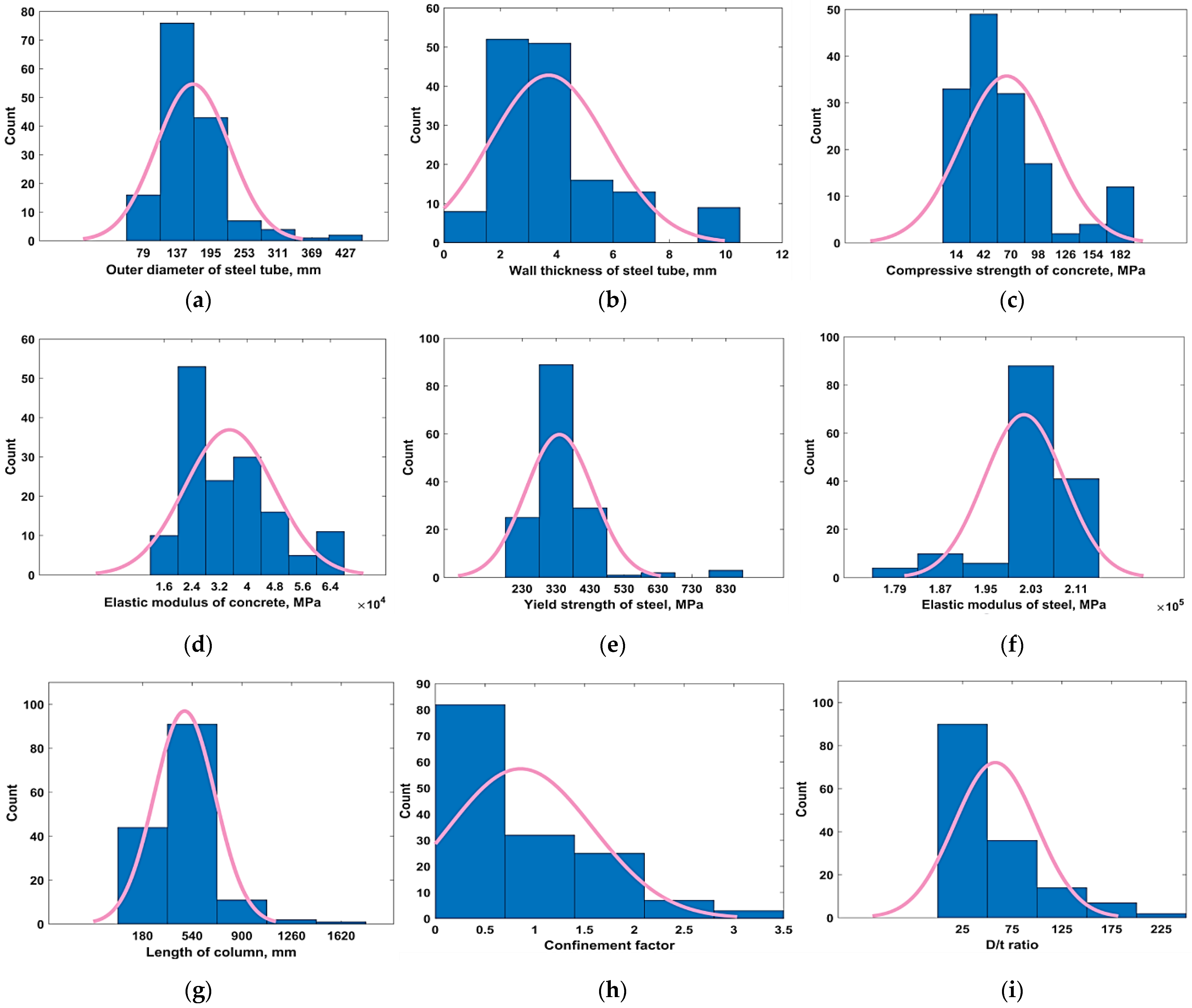
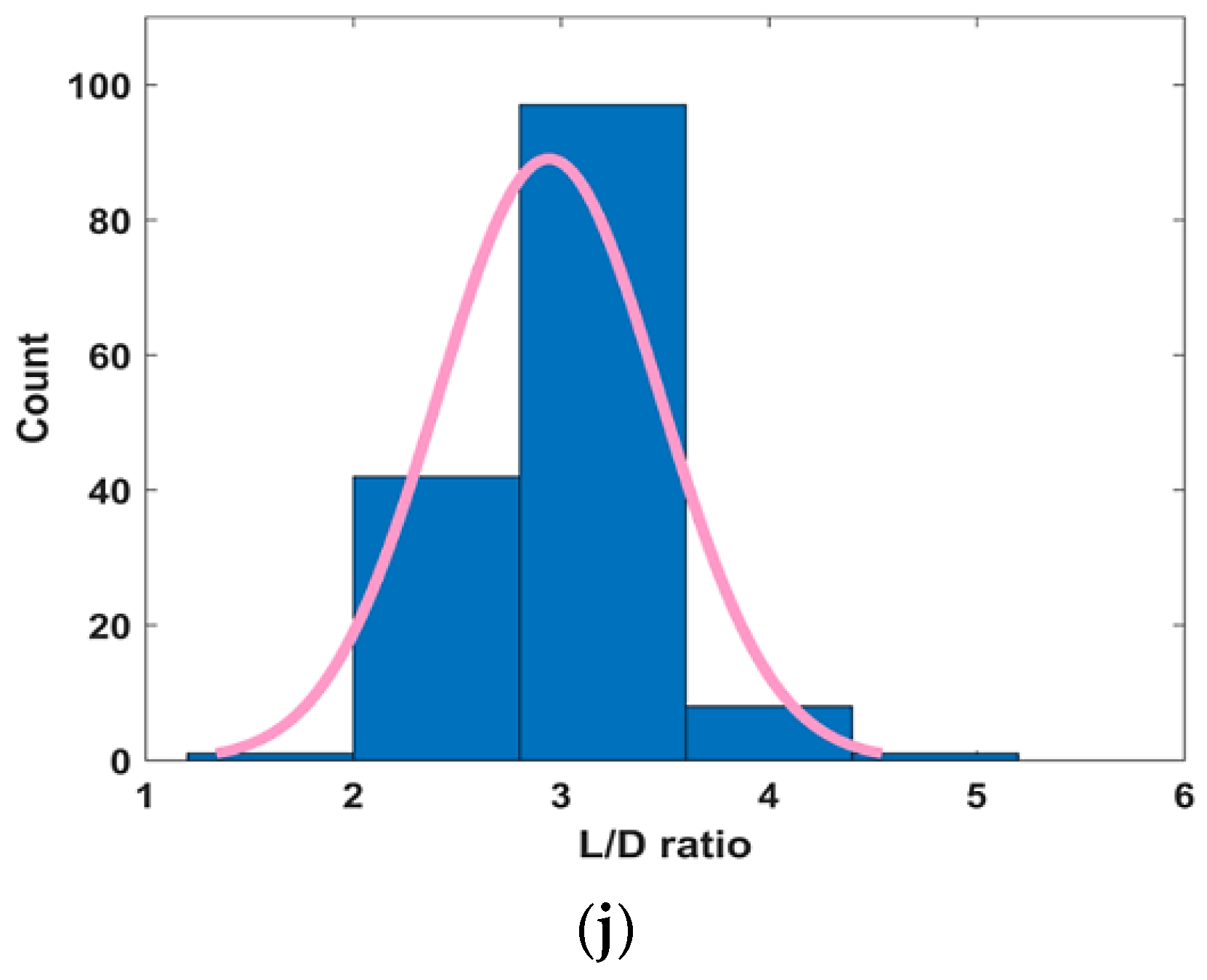
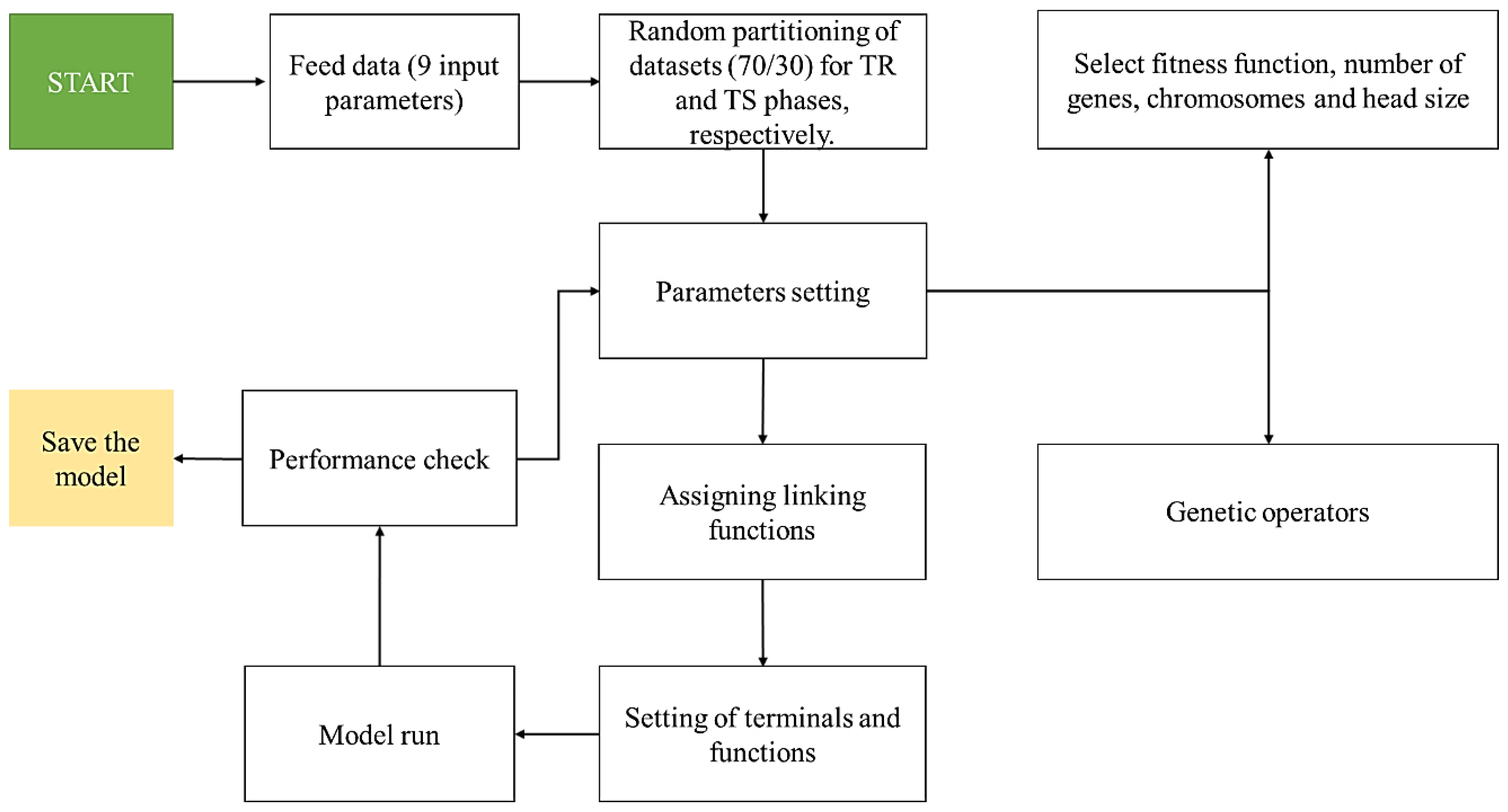
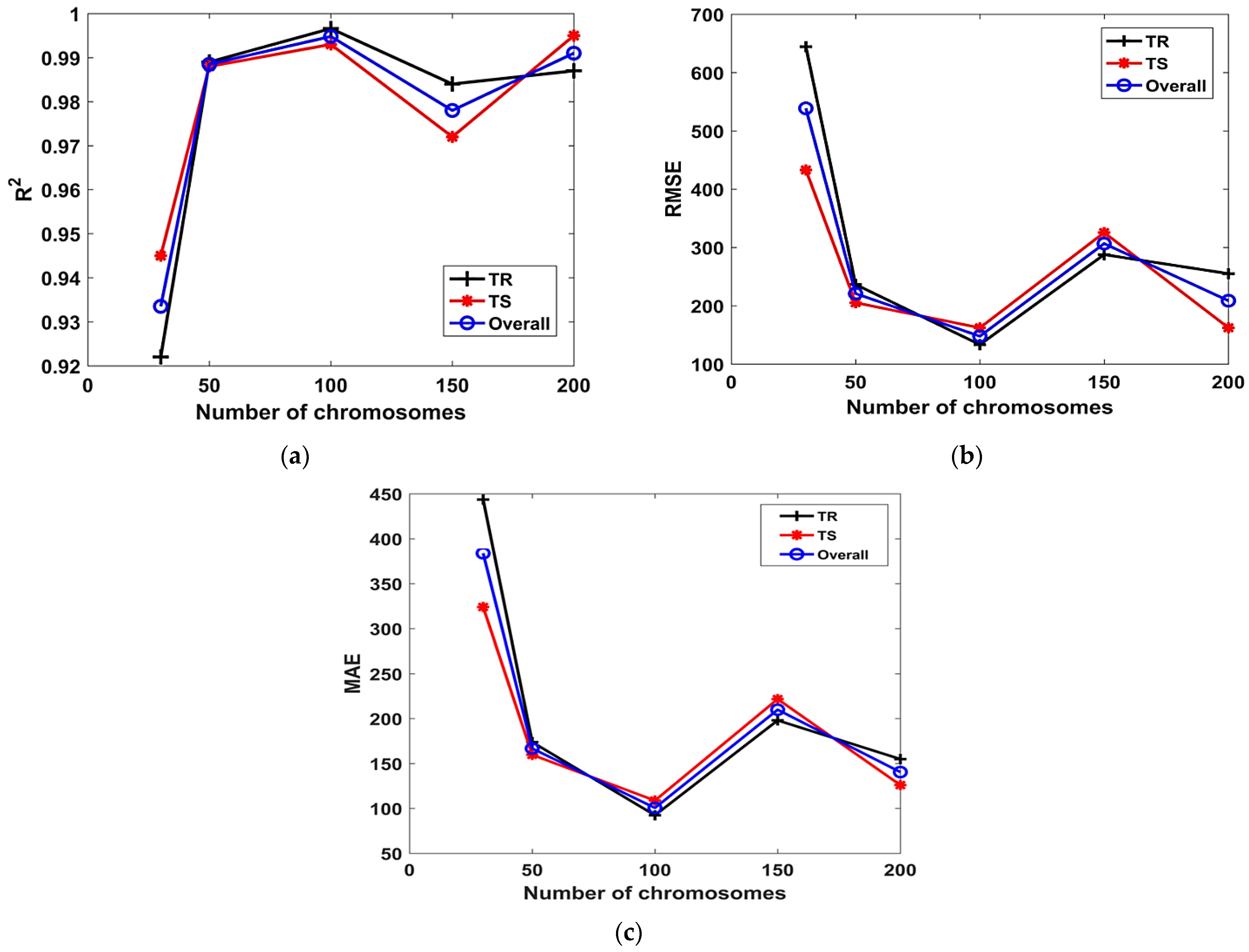
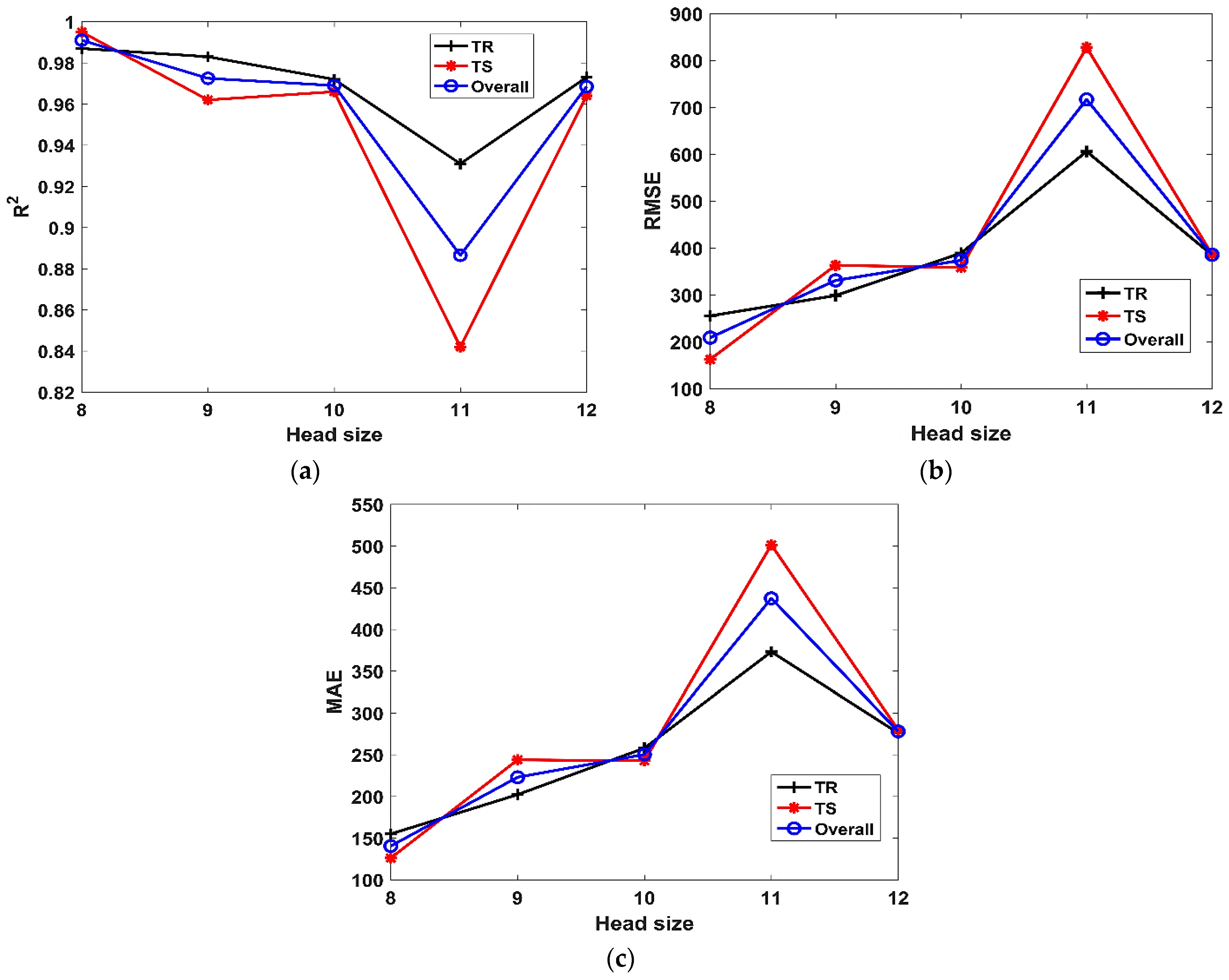




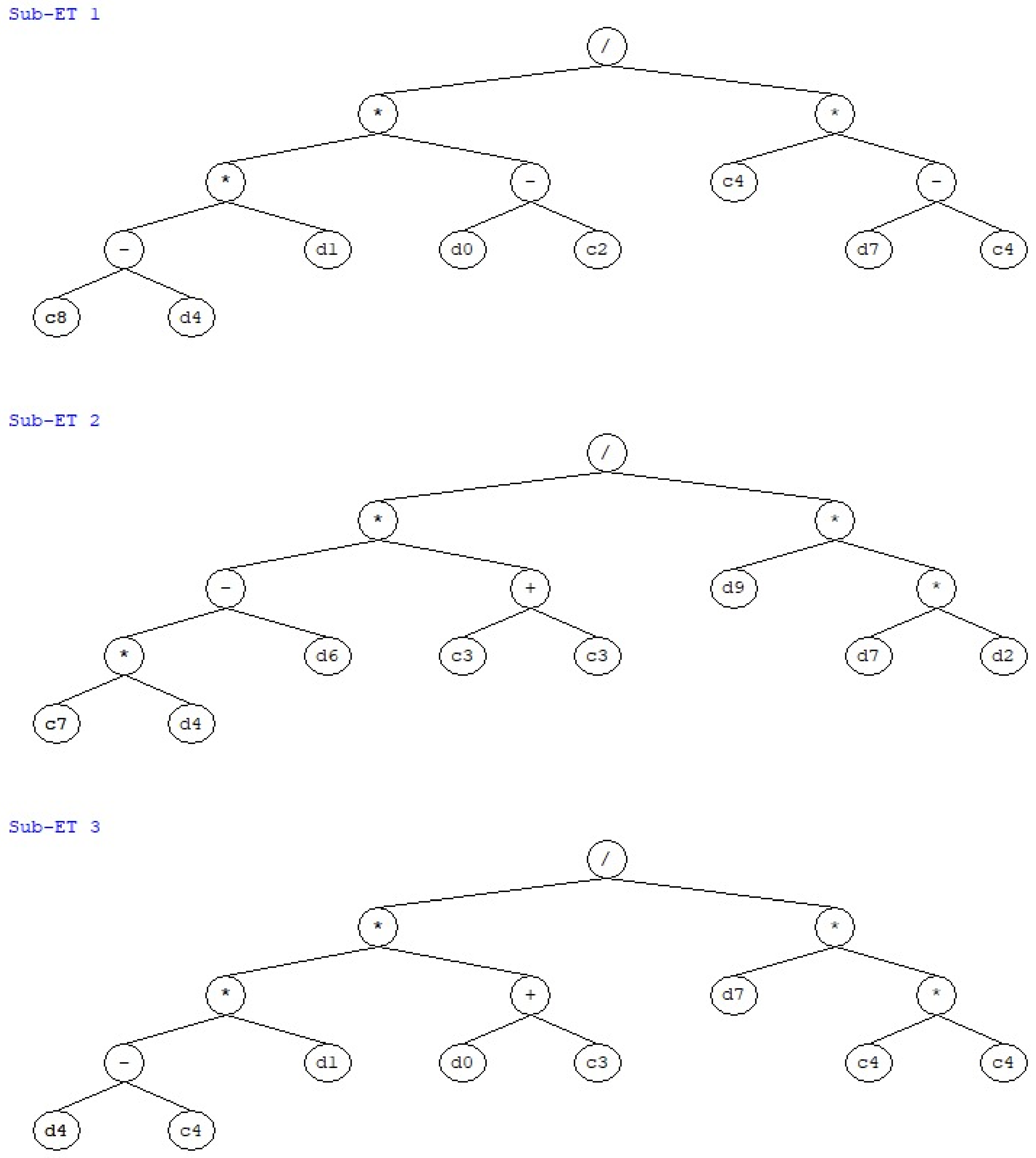
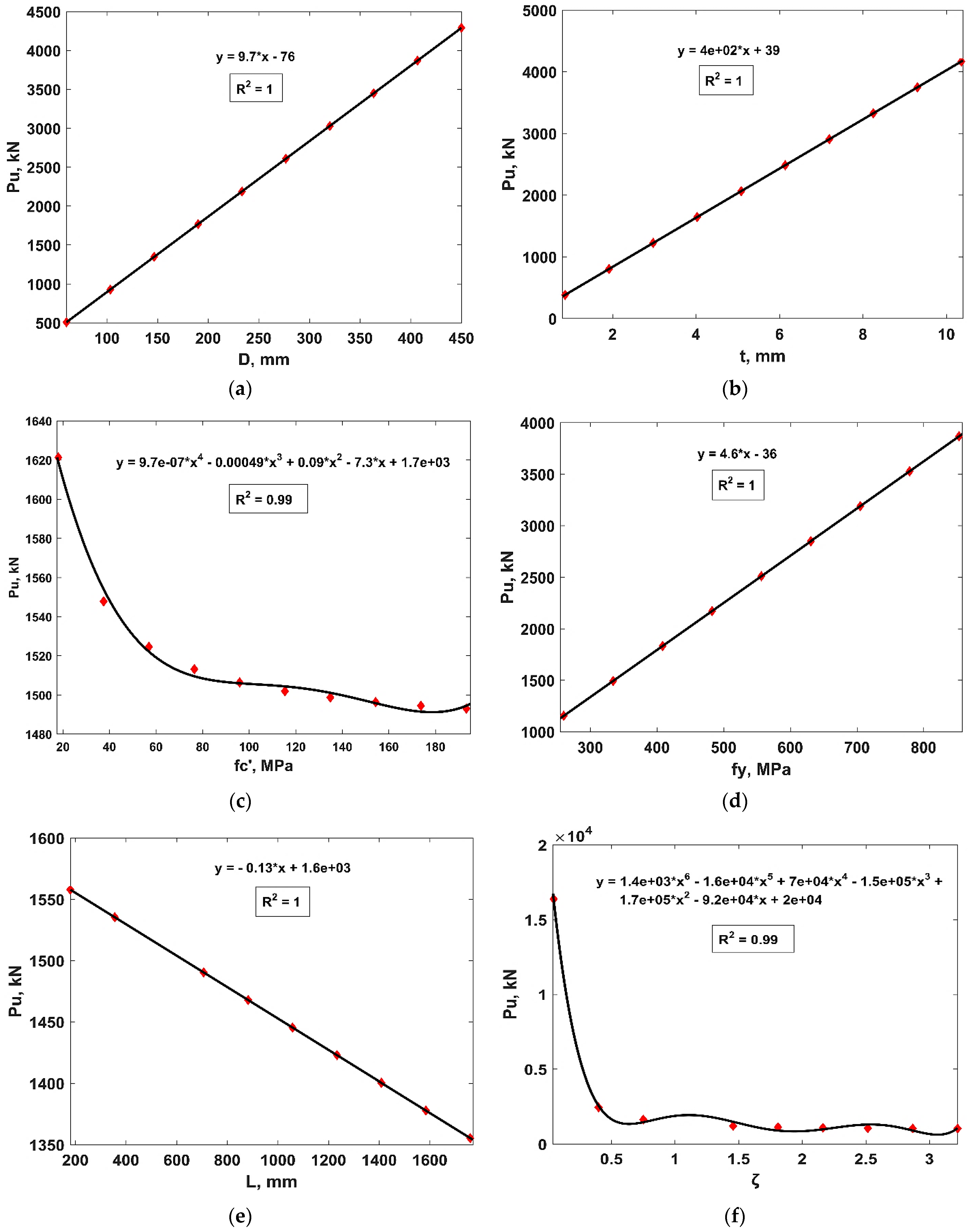

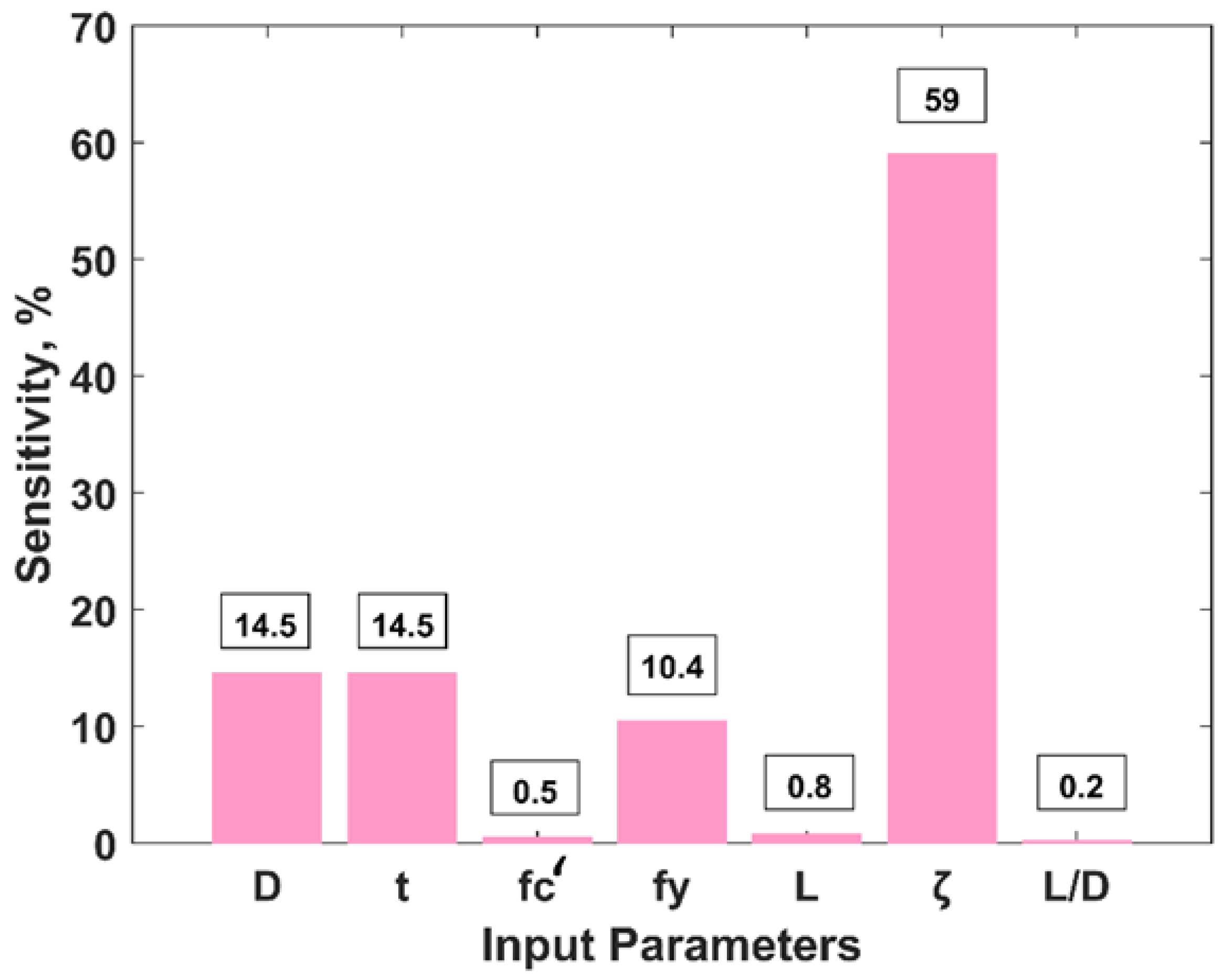
| Reference | Model | Number of Data Points | Input Variables | Testing Data Performance | |
|---|---|---|---|---|---|
| R2 | MAE | ||||
| Sarir et al. [48] | GEP | 303 | fc’, L, D, fy, t | 0.939 | _ |
| Javed et al. [49] | GEP | 227 | fc’, L, D, fy, t, L/D | 0.980 | 153.9 |
| Khan et al. [54] | GEP | 702 | fc’, L, D, fy, t, et, eb | 0.981 | 290.36 |
| Ngo et al. [50] | SVR-GWO | 802 | fc’, L, D, fy, t, D/t | 0.996 | _ |
| Jiang et al. [51] | GEP | 32 | D, L, t, L/D, D/t, fy, Es, f’c, Ec, υ | _ | _ |
| Jayalekshmi et al. [52] | ANN | 633 | D, t, fy, fc’, L | 0.962 | _ |
| Ahmadi et al. [53] | ANN | 272 | D, t, fy, fc’, L | 0.801 | _ |
| This study | GEP | 149 | D, t, fc’, Ec, fy, Es, L, ζ, D/t, L/D | 0.99 | 108.7 |
| Descriptive Statistics | D (mm) | T (mm) | fc’ (MPa) | Ec (MPa) | fy (MPa) | Es (MPa) | L (mm) | ζ | D/t (mm/mm) | L/D (mm/mm) |
|---|---|---|---|---|---|---|---|---|---|---|
| Average | 164.38 | 3.71 | 65.60 | 3.5 × 104 | 339.85 | 201,767 | 485.07 | 0.86 | 58.07 | 2.94 |
| Standard Error | 5.17 | 0.17 | 3.82 | 1.1 × 103 | 8.16 | 575.81 | 18.08 | 0.06 | 3.38 | 0.04 |
| Standard Deviation | 63.09 | 2.08 | 46.58 | 1.3 × 104 | 99.57 | 7029 | 220.73 | 0.73 | 41.21 | 0.53 |
| Sample Variance | 3980 | 4.34 | 2170 | 1.66 × 108 | 9914 | 49,401,978 | 48,721 | 1 | 1698 | 0 |
| Kurtosis | 5.18 | 1.90 | 0.80 | −0.18 | 11.50 | 2.21 | 9.12 | 0.94 | 3.03 | 0.84 |
| Skewness | 1.79 | 1.40 | 1.24 | 0.83 | 2.75 | −1.01 | 2.32 | 1.19 | 1.78 | 0.08 |
| Minimum | 60 | 0.86 | 18.03 | 1.8 × 104 | 186 | 177,000 | 180 | 0.05 | 17 | 1.8 |
| Maximum | 450 | 10.36 | 193.30 | 6.6 × 104 | 853 | 213,000 | 1760 | 3.22 | 221 | 4.90 |
| Parameters | Settings |
|---|---|
| Axial Capacity (Pu) of CFSS | |
| Numerical constants | |
| Constant per gene | 10 Floating number 10 [−10, 10] |
| Type of data | |
| Maximum complexity | |
| Ephemeral random constant | |
| Genetic operators | |
| Rate of mutation | 0.00138 |
| Inversion rate | 0.00546 |
| IS transposition rate | |
| RIS transposition rate | |
| 1-point recombination rate | 0.00277 |
| 2-point recombination rate | |
| Gene recombination rate | |
| Gene transposition rate |
| Trial/Model | No. of Variables | No. of Chromosomes | Head Size | No. of Genes | TR Phase | TS Phase | ||||
|---|---|---|---|---|---|---|---|---|---|---|
| R2 | RMSE | MAE | R2 | RMSE | MAE | |||||
| T1 | 5 | 30 | 8 | 3 | 0.92 | 644.4 | 443.6 | 0.94 | 432.9 | 323.9 |
| T2 | 7 | 50 | 8 | 3 | 0.98 | 236.5 | 173.8 | 0.98 | 205.3 | 159.6 |
| T3 | 7 | 100 | 8 | 3 | 0.99 | 133.4 | 92.4 | 0.99 | 162.2 | 108.7 |
| T4 | 8 | 150 | 8 | 3 | 0.98 | 287.8 | 198.1 | 0.97 | 325.5 | 221.7 |
| T5 | 9 | 200 | 8 | 3 | 0.98 | 255.1 | 154.9 | 0.99 | 162.3 | 126.0 |
| T6 | 7 | 100 | 9 | 3 | 0.98 | 298.5 | 202.1 | 0.96 | 363.1 | 243.8 |
| T7 | 8 | 100 | 10 | 3 | 0.97 | 389.0 | 257.9 | 0.96 | 358.3 | 242.7 |
| T8 | 7 | 100 | 11 | 3 | 0.93 | 605.8 | 373.1 | 0.84 | 828.0 | 501.3 |
| T9 | 8 | 100 | 12 | 3 | 0.97 | 385.1 | 276.0 | 0.96 | 386.0 | 279.8 |
| T10 | 8 | 100 | 8 | 4 | 0.98 | 313.6 | 209.9 | 0.97 | 298.2 | 222.7 |
| T11 | 8 | 100 | 8 | 5 | 0.96 | 443.8 | 286.2 | 0.98 | 288.9 | 218.5 |
| Index | Range/Ideal Value |
|---|---|
| R2 | (0–1)/1 |
| RMSE | |
| MAE |
| Statistic | R2 | RMSE | MAE | |||
|---|---|---|---|---|---|---|
| Rank | 1st | 2nd | 1st | 2nd | 1st | 2nd |
| TR Phase | T3 | T2, T5 | T3 | T2 | T3 | T5 |
| TS Phase | T3 | T5 | T3 | T5 | T3 | T5 |
| Input Variables | Constant Input Parameters | No. of DataPoints | |
|---|---|---|---|
| Parameter | Range | ||
| D | 60–450 | t = 3.71, fc’ = 65.60, fy = 339.85, L = 485.07, ζ = 0.86, L/D = 2.94 | 10 |
| t | 0.86–10.36 | D = 164.34, fc’ = 65.60, fy = 339.85, L = 485.07, ζ = 0.86, L/D = 2.94 | |
| fc’ | 18.03–193.30 | D = 164.34, t = 3.71, fy = 339.85, L = 485.07, ζ = 0.86, L/D = 2.94 | |
| fy | 186–853 | D = 164.34, t = 3.71, fc’ = 65.60, L = 485.07, ζ = 0.86, L/D = 2.94 | |
| L | 180–1760 | D = 164.34, t = 3.71, fc’ = 65.60, fy = 339.85, ζ = 0.86, L/D = 2.94 | |
| ζ | 0.045–3.221 | D = 164.34, t = 3.71, fc’ = 65.60, fy = 339.85, L = 485.07, L/D = 2.94 | |
| L/D | 1.8–4.9 | D = 164.34, t = 3.71, fc’ = 65.60, fy = 339.85, L = 485.07, ζ = 0.86, | |
Publisher’s Note: MDPI stays neutral with regard to jurisdictional claims in published maps and institutional affiliations. |
© 2022 by the authors. Licensee MDPI, Basel, Switzerland. This article is an open access article distributed under the terms and conditions of the Creative Commons Attribution (CC BY) license (https://creativecommons.org/licenses/by/4.0/).
Share and Cite
Khan, K.; Iqbal, M.; Raheel, M.; Amin, M.N.; Alabdullah, A.A.; Abu-Arab, A.M.; Jalal, F.E. Prediction of Axial Capacity of Concrete Filled Steel Tubes Using Gene Expression Programming. Materials 2022, 15, 6969. https://doi.org/10.3390/ma15196969
Khan K, Iqbal M, Raheel M, Amin MN, Alabdullah AA, Abu-Arab AM, Jalal FE. Prediction of Axial Capacity of Concrete Filled Steel Tubes Using Gene Expression Programming. Materials. 2022; 15(19):6969. https://doi.org/10.3390/ma15196969
Chicago/Turabian StyleKhan, Kaffayatullah, Mudassir Iqbal, Muhammad Raheel, Muhammad Nasir Amin, Anas Abdulalim Alabdullah, Abdullah M. Abu-Arab, and Fazal E. Jalal. 2022. "Prediction of Axial Capacity of Concrete Filled Steel Tubes Using Gene Expression Programming" Materials 15, no. 19: 6969. https://doi.org/10.3390/ma15196969
APA StyleKhan, K., Iqbal, M., Raheel, M., Amin, M. N., Alabdullah, A. A., Abu-Arab, A. M., & Jalal, F. E. (2022). Prediction of Axial Capacity of Concrete Filled Steel Tubes Using Gene Expression Programming. Materials, 15(19), 6969. https://doi.org/10.3390/ma15196969








